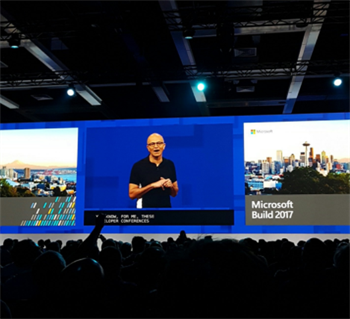Sam Vanhoutte, CTO of Codit, was present at Microsoft Build 2017 and is reporting for us. Codit collaborates with Microsoft and their product teams, but we also place value in coming to these events and hearing about all the new announcements. The main focus for Build, by the way, is on developers. Therefore, we will not be talking about upcoming versions of Windows 10.
Unlike other years, Build was not held in San Francisco but instead has moved to Seattle. There, CEO Satya Nadella shared his vision for developers. He points out that there are a lot of opportunities, but that opportunities also come with responsibilities.
Nadella indicated the evolution of the Internet using a few numbers. In 1992, the total internet volume was 100 gigabytes per day. Today, the world consumes 17,5 million times more, only now per second. Ninety percent of all data was generated over the past two years. Of course, this number will multiply because of the billions of connected devices and sensors that are going to be connected in the near future.

Microsoft in numbers
Microsoft also mentioned numbers about themselves. For instance: there are now 500 million Windows 10 devices. The commercial version of Office 365 has 100 million active users per month and Cortana has over 140 million users per month.
Azure Active Directory is currently being used by 12 million organizations. And over 90 percent of Fortune 500 companies use the Microsoft Cloud.
IoT
Microsoft is currently investing heavily in IoT, and notes that in the smart industry ‘the edge’ is going to be very important. ‘The edge’ means the periphery of the network, where sensors and devices generate their data (and sometimes process data) before it is moved to a cloud service.
This is also reflected in the product news: Azure IoT Edge is combination of the intelligent cloud and the intelligent edge. The system enables cloud functionality to be executed in ‘the edge’. This functionality includes gateways, machine learning, stream analytics and functions that can now be executed locally, but are managed and configured from the cloud.
The reason is that it is increasingly common for large amounts of data to be processed quickly. Sometimes this is better done locally. It must be noted that Microsoft is not the only one to move in that direction. Bosch also mentioned such local processing, quoting the term ‘fog computing’.
Codit is pleased with the expansion. Sam Vanhoutte said “This is also very important for Codit and it is a major evolution in Microsoft’s IoT offering, closely involving us as Azure IoT Elite partner”.
AI
In the area of artificial intelligence, Microsoft presented products like Microsoft Graph. The software links people, their activities and their devices together. Combined with machine learning and cognitive services, the company gave a demo where alerts were being generated when unauthorized persons use certain items on the work floor.
In addition, Microsoft also introduced several new cognitive services, many them being fully customizable. This allows you to get started with machine learning by doing things like ‘feeding’ images of certain objects to the system. Another demo showed live captioning during a PowerPoint presentation. This is something that IBM also demonstrated during their Watson conference last fall.
Azure
The fact that Microsoft is more than Windows and Office becomes clear as soon as Azure moves into the spotlight. For example, a new database service by the name of Azure CosmosDB was presented, able to store and present data quickly and reliably on a worldwide scale. Storage possibilities include NoSQL documents, graphs and key-value.
Also new are two managed databases: Managed MySQL and Managed PostreSQL.
For containers, developers had the choice of using Docker, Kubernetes and Mesos on Azure. This is supplemented with Service Fabric for Windows or Linux. Also, live debugging is possible in a production environment without impacting users.
But there is more…
Finally, Microsoft announced the Azure mobile app, Visual Studio for Mac and a built-in script console in the Azure portal. These are all things that make the life of devops easier.
For developers, Microsoft announces the XAML standard 1.0. It should make it even easier to develop apps that run on Windows, iOS and Android. Microsoft also expanded on how to make apps more accessible to people with disabilities.
What does this mean for Belgium?
According to Sam Vanhoutte, Microsoft’s cloud tools can help companies in their digital transformation. “It will be easier for many customers to achieve innovation in an inexpensive and fast-paced manner. Fail fast and pay as you grow.” Also, the increased availability of AI can provide efficiency gains for local companies.
The fact that Microsoft is now offering ‘edge’ products and services is a new trend in the cloud landscape. However, according to Vanhoutte, it is not yet clear how all these new features are included in the pricing.
Codit also received kudos during the Build conference. Swiss Re, a Swiss insurance company and a customer of Codit, was asked to present a case in which travelers received reimbursement immediately after their flight had been delayed.
If you want to learn about all the announcements done at Build 2017, you can go to Channel 9, Microsoft’s video service, and rerun the live streams.
Note: This article was first published via Data News (in Dutch).
Subscribe to our RSS feed